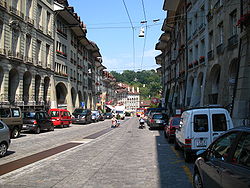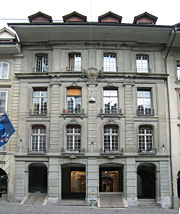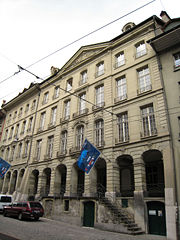
Gerechtigkeitsgasse
Encyclopedia


Switzerland
Switzerland name of one of the Swiss cantons. ; ; ; or ), in its full name the Swiss Confederation , is a federal republic consisting of 26 cantons, with Bern as the seat of the federal authorities. The country is situated in Western Europe,Or Central Europe depending on the definition....
. Together with its extension, the Kramgasse
Kramgasse
The Kramgasse is one of the principal streets in the Old City of Bern, the medieval city center of Bern, Switzerland. It was the center of urban life in Bern up until the 19th century. Today, it is a popular shopping street...
, it is the heart of the inner city. Hans Gieng
Hans Gieng
Hans Gieng was a Swiss Renaissance sculptor best known for his public fountain figures in the Old Town of Bern as well as Fribourg.- Biography :...
's most famous fountain figure, the statue of Lady Justice
Lady Justice
Lady Justice |Dike]]) is an allegorical personification of the moral force in judicial systems.-Depiction:The personification of justice balancing the scales of truth and fairness dates back to the Goddess Maat, and later Isis, of ancient Egypt. The Hellenic deities Themis and Dike were later...
on the Gerechtigkeitsbrunnen
Gerechtigkeitsbrunnen (Berne)
The Gerechtigkeitsbrunnen is a 16th-century fountain in the Gerechtigkeitsgasse in the Old City of Bern, Switzerland...
, commands the view of the street's gentle slopes and curves.
The Gerechtigkeitsgasse and its buildings are a heritage site of national significance
Swiss Inventory of Cultural Property of National and Regional Significance
The Swiss Inventory of Cultural Property of National and Regional Significance is a register of some 8,300 items of cultural property in Switzerland...
and part of the UNESCO
UNESCO
The United Nations Educational, Scientific and Cultural Organization is a specialized agency of the United Nations...
Cultural World Heritage Site
World Heritage Site
A UNESCO World Heritage Site is a place that is listed by the UNESCO as of special cultural or physical significance...
that encompasses the Old City.
Topography
The Gerechtigkeitsgasse is 260 metres (853 ft) long. It is the eastern half and the oldest part of the central East-West axis of the city's oldest neighbourhood, the Zähringerstadt, built right after the founding of the city in 1191. It continues to the west as the KramgasseKramgasse
The Kramgasse is one of the principal streets in the Old City of Bern, the medieval city center of Bern, Switzerland. It was the center of urban life in Bern up until the 19th century. Today, it is a popular shopping street...
after being crossed by the Kreuzgasse. In the west, the Gerechtigkeitsgasse bifurcates as it enters the Nydegg
Nydegg
The Nydegg is a historic section in the Old City of Bern in Bern, Switzerland.The first expansion of Bern occurred as the city was founded in 1191. At the east end of the central and oldest neighbourhood, the Zähringerstadt , was the Nydegg castle near the banks of the Aare river. The houses that...
neighbourhood: the Nydeggstalden
Nydeggstalden
The Nydeggstalden is one of the streets in the Old City of Bern, the medieval city center of Bern, Switzerland. It is part of the Nydegg which was part of the medieval industrial section of Bern. It is a semi-circular road running from Gerechtigkeitsgasse toward the Aare river and the...
leads to the Untertorbrücke, and the Nydeggasse to the more recent Nydeggbrücke
Nydeggbrücke
The Nydeggbrücke is a bridge in Bern, Switzerland which connects the eastern part of the old city to the new part. It crosses over the Aare River and is located very close to the Bärengraben. It was built in parallel to the Untertorbrücke in 1840, which until then had been the only bridge crossing...
. Several narrow alleys and passageways connect the Kramgasse to the parallel Postgasse
Postgasse
The Postgasse is one of the streets in the Old City of Bern, the medieval city center of Bern, Switzerland. It is part of the Zähringerstadt which was built during the foundation of the city in 1191. It runs from Nydeggstalden near the Aare river in the east to the transverse Kreuzgasse, where the...
in the north and the Junkerngasse
Junkerngasse
-External links:...
in the south.
The Gerechtigkeitsgasse cannot be reached by car without a special permit. It is accessible by foot or bike or by means of the Bernmobil bus line no. 12 that runs through it and stops at either end of the street (Rathaus and Nydegg). Both sides of the street are covered with Lauben
Lauben
Lauben is a municipality in the district of Oberallgäu in Bavaria in Germany....
, stone arcades
Arcade (architecture)
An arcade is a succession of arches, each counterthrusting the next, supported by columns or piers or a covered walk enclosed by a line of such arches on one or both sides. In warmer or wet climates, exterior arcades provide shelter for pedestrians....
that protect pedestrians from inclement weather.
History
The Gerechtigkeitsgasse was the main street of the town at the time of its founding. With its original width of around 26 metres (85.3 ft), reduced to 18 metres (59.1 ft) after the construction of the arcades, it also served as the central marketplace of medieval Bern. For this reason, the Gerechtigkeitsgasse and the Kramgasse together were called the Märitgasse (Swiss German for "Market Alley") up until the 16th century. After that time, the markets moved west towards the ZytgloggeZytglogge
The Zytglogge tower is a landmark medieval tower in Bern, Switzerland. Built in the early 13th century, it has served the city as guard tower, prison, clock tower, centre of urban life and civic memorial....
, and the street came to be called by der Gerechtigkeit ("near [Lady] Justice"), in reference to the fountain installed in 1543. Only in 1798 was the street officially renamed Gerechtigkeitsgasse. The meat and bread stalls, the tannery and most guilds also moved out of the street between 1450 and 1550 as it gradually became a residential area mainly for the ruling noble families. The urban tribunal
Tribunal
A tribunal in the general sense is any person or institution with the authority to judge, adjudicate on, or determine claims or disputes—whether or not it is called a tribunal in its title....
with its pillory
Pillory
The pillory was a device made of a wooden or metal framework erected on a post, with holes for securing the head and hands, formerly used for punishment by public humiliation and often further physical abuse, sometimes lethal...
and judge's chair made of stone remained located in the street near the Kreuzgasse significantly longer.
On the eastern end, the streetscape was altered by the slighting
Slighting
A slighting is the deliberate destruction, partial or complete, of a fortification without opposition. During the English Civil War this was to render it unusable as a fort.-Middle Ages:...
of Nydegg Castle in 1270, the demolition of other fortifications up until 1405 and several excavations of the roadbed up until 1764 to reduce the street's downward slope. In 2005, the street was thoroughly renovated and its cobblestone
Cobblestone
Cobblestones are stones that were frequently used in the pavement of early streets. "Cobblestone" is derived from the very old English word "cob", which had a wide range of meanings, one of which was "rounded lump" with overtones of large size...
pavement replaced. The city ditch (Stadtbach) running through the middle of the street since medieval times is now visible again through metal gratings.
Buildings


Renaissance architecture
Renaissance architecture is the architecture of the period between the early 15th and early 17th centuries in different regions of Europe, demonstrating a conscious revival and development of certain elements of ancient Greek and Roman thought and material culture. Stylistically, Renaissance...
and the early Baroque
Baroque architecture
Baroque architecture is a term used to describe the building style of the Baroque era, begun in late sixteenth century Italy, that took the Roman vocabulary of Renaissance architecture and used it in a new rhetorical and theatrical fashion, often to express the triumph of the Catholic Church and...
touched the outside of the buildings only lightly. As in the Kramgasse, two thirds of the houses received new façades up until 1780, reshaping most of the eastern and central part of the street in the image of the late Baroque. Unlike other streets, no substantial changes were made to the streetscape since; a project to demolish five houses in 1954 was prevented by exceptionally broad public opposition, receiving international support.
House no. 7, the Goldener Adler ("Golden Eagle"), is Bern's oldest hostel and tavern. It was first recorded in 1489 as Weisses Kreuz; the building is a 1764 construction by N. Hebler. The eagle head holding the inn sign is one of the chief works of this type in Switzerland. No. 40 is Bern's most expansive urban palais; it is exemplary for the insertion of a French hôtel
Hotel
A hotel is an establishment that provides paid lodging on a short-term basis. The provision of basic accommodation, in times past, consisting only of a room with a bed, a cupboard, a small table and a washstand has largely been replaced by rooms with modern facilities, including en-suite bathrooms...
in the medieval cityscape. It was built in 1743 by Albrecht Türler for Alexander von Wattenwyl and was the site of the surrender of the Helvetic
Helvetic Republic
In Swiss history, the Helvetic Republic represented an early attempt to impose a central authority over Switzerland, which until then consisted mainly of self-governing cantons united by a loose military alliance, and conquered territories such as Vaud...
government to French troops on 18 September 1802. No. 42 is the first certain work of Türler, who was 28 years old when designing it in 1734 for Niklaus Jenner.
House no. 33 is significant as a principal work of Bernese manierism with one of the best Régence
Régence
The Régence is the period in French history between 1715 and 1723, when King Louis XV was a minor and the land was governed by a Regent, Philippe d'Orléans, the nephew of Louis XIV of France....
façades and Louis XV interior. It was built in 1608 by Andres Widmer and the exterior was reshaped by Türler in 1740. No. 52, built 1730, is considered to be Niklaus Sprüngli's best town house. No. 56, a rather simple 1730 Régence house, is noted for its exceptional door knocker
Door knocker
A door knocker is an item of door furniture that allows people outside a house to alert those inside to their presence. A door knocker has a part fixed to the door, and a part which is attached to the door by a hinge, and may be lifted and used to strike a plate fitted to the door, or the door...
. No. 62 houses the Klötzlikeller restaurant. Established in 1632, it is the last of originally more than 200 cellar taverns of Bern. No. 79, the Gesellschaftshaus zum Distelzwang, built 1703 by Samuel Jenner, is a principal work of early Baroque architecture in Bern.

